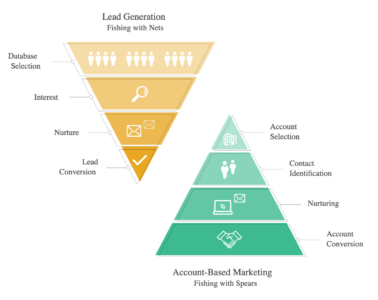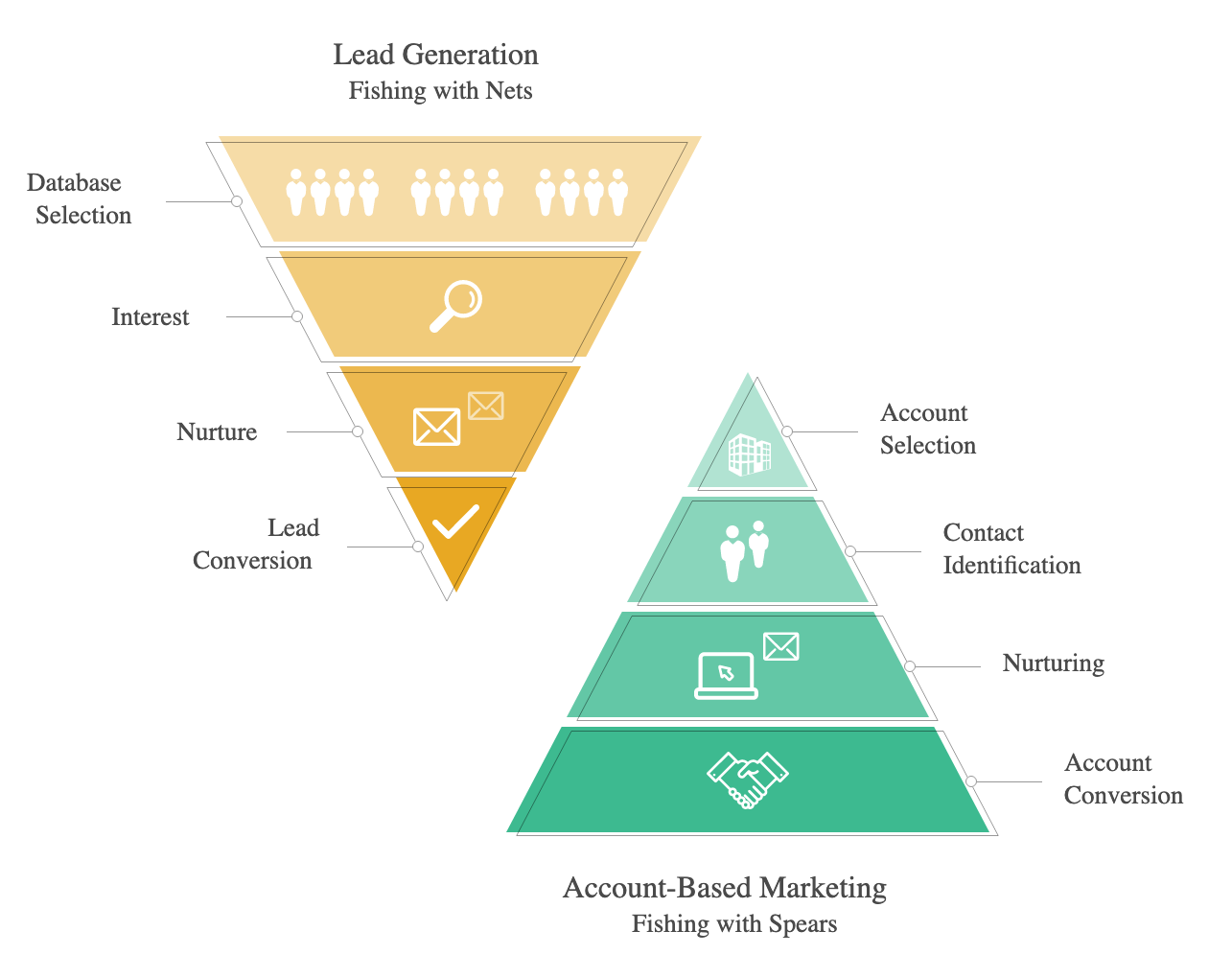Right now, Account-based Marketing (ABM) is the hottest B2B ticket in town—87% of marketers believe it offers better ROI than other marketing activities.
Although it may be a fairly new technique for many people, it has actually been used in various ways for many years. In reality, you may have already heard the word Key Account Management, Main Account Marketing, or Client-centric Marketing.
ABM ‘s goal is, quite simply, to treat one account as a single market , i.e. to focus all of your energy (and resources) on engaging, winning, and maintaining a named account.
On this level, ABM has four basic principles:
- Consumer emphasis and perspective
- Marketing and Sales Partnership
- Focus on credibility, friendship and, eventually, revenue
- Tailored programs and campaigns;
Easy right, huh? Well, the reality is that, in order to justify this level of effort and resources, the prize must be sufficiently large to justify this expenditure. As a result, ABM is ideally suited to complex, high ‘ticket price’ approaches with longer life-cycle sales, typically involving multiple stakeholders.
Over the last few years, strategic ABM (one-to-one) and one-to-one (15-20 pooled accounts with shared commonality, i.e. vertical, industrial, pain, challenge, etc.) have defined ABM.
But there’s a new ABM kid on the block who’s shaking things up: one-to-many ABMs.
The ABM Tech Stack Rise
Some of the primary reasons that ABM has become so common and is now a core part of any B2B marketing and sales process is the use of technology to automate and target certain accounts (and individuals) that you want to impact and convert.
The rise of one-to-many ABM programs targeting hundreds (and even thousands) of accounts was largely possible due to the technological and data advances that are now available to B2B marketers.
QUITE SIMPLY, ONE-TO-MANY ABM WILL NOT WILL BE POSSIBLE SEVERAL YEARS AGO.
Bev Burgess, one of the world’s leading ABM experts, recently said, “One-to-many ABMs now allow businesses to provide a ‘Always-on’ policy for those accounts that are of interest to you.”
What’s Account-based Advertising?
The analogy most commonly used to describe the difference between ABM and Inbound Marketing is parasailing vs. net fishing. As seen in the picture below, ABM is the opposite of Inbound Marketing:

Selection of the accounts is the starting point. As such, being able to target named accounts and the relevant decision-making unit (DMU) within the account from the outset is the foundation of effective Account-based Marketing Program.
And that’s where Account-based Advertising comes in. Account-based Advertisement helps you to hyper-targe and hyper-personalize digital marketing promotions to these designated accounts.
Simply put, account-based advertising implies that the digital advertising strategies are highly targeted and concentrated only on certain accounts that you want to engage, reach and win.
Account-based ads allows you to:
- Amplify your digital advertising campaigns to increase your chances of winning a deal. Expanding your re-targeting from the original site user to the larger DMU would increase your chances significantly.
- We are familiar with the large number of target account contacts involved in the decision-making process (6-10 according to Gartner). Digital advertising allows you to reach and influence this larger, more important group.
- Focus your marketing spending and increase the ROI of your digital advertising budget by targeting those accounts that display intent signals.
How to be Successful with Account-based Advertising
Let’s take a look at what constitutes a successful account-based advertising campaign.
1. Consider advertisement choices based on your account.
There are many digital advertising options available (and the number is increasing). A large number of digital advertising partners and ABM platforms are capable of providing access to these channel tactics.
Make sure you carefully choose your tactics and channels, based on your marketing budget, messaging, and audience.
A) Programmatic Advertising
Many of us know about this form of advertising. These advertisements are created by cookie-based targeting, and advertisements appear natively in-channel, with a much more natural effect. Ads are made available on websites and apps via online platforms such as Google, Avocet or AdRoll publishing networks.
A subset of Programmatic Ads allows you to reach the specific computer that has been looking, as well. This is a step forward from conventional IP-based targeting, especially in the light of the remote-work explosion over the last few months, which will certainly continue for some time to come.
B) LinkedIn Paid Advertising
LinkedIn has been a significant player in the world of digital ads. They offer a (growing) number of formats and options for you to target Accounts and/or Persons of interest to you:
Advertising options, such as Sponsored Content, allow you to feed content to LinkedIn users beyond those who follow you or your company — which allows you to reach unique targets beyond the target accounts. The important benefit is that specific content can be delivered on a scale basis.
In addition, LinkedIn paid ads allows you to test various ad units depending on the campaign goals, which stage of the funnel you want to promote, and the size of the strategies you want to promote.
C) Content Syndication
This is a common awareness-raising strategy that you could use for one-to-many ABMs to promote your content across a broad B2B content syndication network of websites, blogs , social media, etc. (To learn more about how to syndicate your content, take a look at Content Syndication: What It Is & How to Do It Successfully).
(D) Retargeting
We ‘re all familiar with retargeting, but we might not be sure of it. Have you ever noticed that ads are related to your recent search when you’re reading your favorite blog content or browsing Facebook? It’s thanks to the retargeting.
Retargeting is a feature that lets you customize your campaign show ads for people who have previously visited your site, and tailor your advertising (using dynamic retargeting) to those visitors as they browse the web and use social media apps.
The goal here is not to fatigue your audience with the same advertising, but to continually refresh and be important to your audience.
2. Keep your audience and persona top-of-mind when personalizing content.
Data-backed buyer persona research is the foundation of any ABM campaign and this is certainly true of any digital advertising campaign that follows it.
Personalization is key to this. Desk analysis and in-depth perspective reports should shed light on the account and the business to which it belongs. Further research on the DMU and named individuals inside the account can inform the messaging and digital advertisement strategy.
Holding your audience in mind will ensure that the material is resonant.
REMEMBER that your message is going to be taken away by HUMAN BEINGS who are facing SPECIFIC CHALLENGES, so make it a priority for their PAIN POINTS and CHALLENGES.
Always make sure your message is empathetic, builds a friendship, and focuses on how you can help solve their challenges — rather than how big your company is.
Having the employees at the core of the marketing plan would help you see progress with your Account-based advertising campaign. Always review which of your previous campaigns have strongly resonated with your audience — what content formats and language do they best respond to?
3. Make your messages as relevant as possible to your target audience.
With ABM’s one-to-one program, you can study the target client in depth to ensure that your message is as important as possible, addressing both the concerns of the customer and the organization at large. For a one-to-few system, you can be able to tailor the message through either industry segment or sales request.
Even on a one-to-many basis, consider how you can add light-touch flexibility and keep it significant. Review whether the advertising / channel you choose allows you to add some useful customization tokens, including first name, last name, company name, job title, and industry.
As a general rule, it’s best not to get too carried away with the number of CTAs you ‘re using. Instead of presenting users with a short message and five CTAs, start by forcing them to take the most important action first (such as downloading an ebook) and then stagger additional options using the sequence to ensure there is a sufficient context for each offer. The ‘ask’ is supposed to be crystal clear!
4. Consider your searcher’s intent and use the right keywords to match it.
Intent data will offer useful insights to help you ensure that you target only those accounts that are on an active purchaser’s journey. The image below shows the process of narrowing down the initial ‘in-house’ Target Account list by a) looking at your first party data — who is engaged with your brand? b) use purpose data to see which accounts are on an successful purchaser’s journey.
This intersection of first and third-party data is a sweet spot where your Account-based Advertising can be deployed at will.
Likewise, when it comes to the topics and messages you ‘re sharing, intent data can ensure that they resonate with your intended audience. What keywords are they floating around, and does your message address questions that they’re actively trying to solve?
Work any relevant keywords in your sequence … Without going overboard, of course, with buzzwords!
Even though your audience may be trending around multiple themes, it’s best to keep your message focused on just one topic to avoid confusion. This ad format works especially well when you have multiple assets around a single topic — ebook, video, and blog posts, for example. This makes it possible for users who are not yet ready to convert to explore some of your other content and increase the awareness of your brand within the audience.
It’s All In Your Hands
Account-based marketing is clearly here to stay, and more and more organizations will be adopting or expanding their existing ABM programs.
Data and technology are now opening up a multitude of opportunities for B2B marketers to offer hyper-personalized experience that will only increase as new ways are found to find and target accounts that you want to win or expand. Account-based ads should be an interesting place to watch in the coming months and years.
![]()



